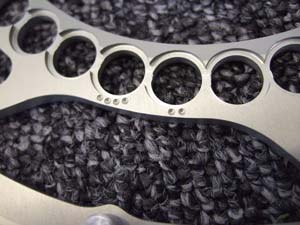 Marks denote suitable mounting holes |
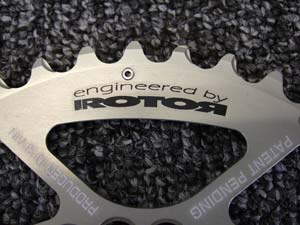 Spanish cycle engineering is making waves |
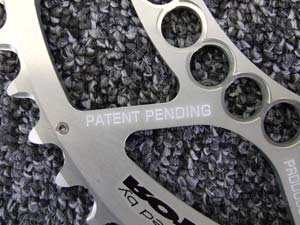 Patent on multiple mounting holes |
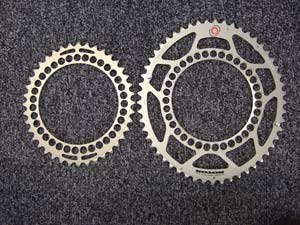 Non-circular indeed |
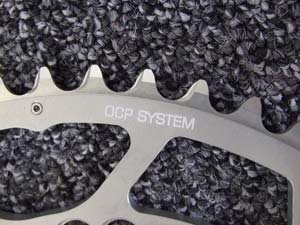 Optimum Chainring Position on both rings |
Rotor Q-Rings Shimano 130BCD 53/40 £100.00
Non-circular chainrings have a long and intriguing history that stretches back almost as far as the invention of the rear-driven safety bicycle itself. They have tended to reappear at regular intervals that seem to coincide with the length of time it takes a generation of cyclists to forget the lack of success of its own version of the idea. Shimano’s Biopace chainrings had until recently been widely assumed to have put paid to the whole thing, having been almost universally panned by those who tried them. However, non-circular rings have never entirely gone away, with small-scale production of Egg rings and their like keeping the flag flying, and recently there have been several attempts to revive interest.
The obvious question is, what is so different about new designs? Which in turn begs the question, how are they supposed to work in the first place? Most such rings are roughly elliptical, with a long and a short axis. A circular chainring acts as a lever arm of constant specific length pulling on the chain, whereas a non-circular ring acts as a lever arm of variable length. This is intended to act in concert with the way the human leg generates a variable force on the crank as it follows the pedalling circle; at the point where the leg produces most pedalling force, the elliptical ring has its greatest radius and longest effective lever arm. Likewise, where the leg produces its least amount of force, the ring will have its smallest radius. Effectively, the leg is supposedly enabled to do most work where it is strongest.
Put this way, the non-circular ring sounds like the only sensible way to go, which is probably why it has been so popular with inventors over the years. However, studies have shown, almost without exception, no perceptible advantage to non-circular rings. Indeed, some have even shown a disadvantage of up to 5percent.
Rotor’s Q-Ring design is claimed to increase power output, make high cadences easier and soften movement through ‘dead spots’, so the Spanish company clearly believes its product does what previous efforts have never been shown to do. For sure, they do not seem to have hampered women’s world road race champion Marianne Vos, who rides them on the road and in cyclo-cross.
If there is one obvious difference with preceding attempts, it is Rotor’s Optimum Chainring Position (OCP) System, which allows the ring axes to be orientated with the crank almost exactly as the rider wishes. In the case of the 130mm BCD rings tested, there are 35 mounting holes for the chainring bolts; since there are two identical orientations 180deg apart for each ring, this means there are 70 possible ways the ring can be positioned, each just over 5deg apart. To aid with setup, Rotor marks five of these holes, grouped two on one side and three on the other, with punch marks that indicate the suggested five most effective possible orientations. The rider can try them out to find which one works best.
With the 53t ring, the maximum radius equates to a 56t ring, while the minimum radius matches that of a 51t ring. What this means in practice is that the instantaneous ‘feel’ of the ring at either of those points is the same as that of the matching ring size. RCUK found that initial sensations are of notably easy riding, especially into a headwind, at a slightly higher cadence than normal, although cadences of more than about 110rpm are less comfortable than with a circular ring. These are, of course, subjective and by no means conclusive, hence the need for more scientific tests. Watch this space.





